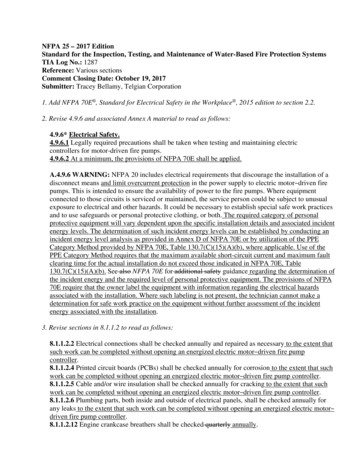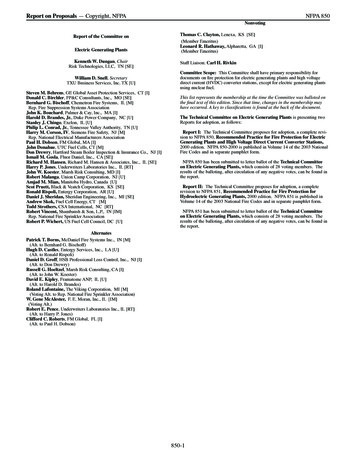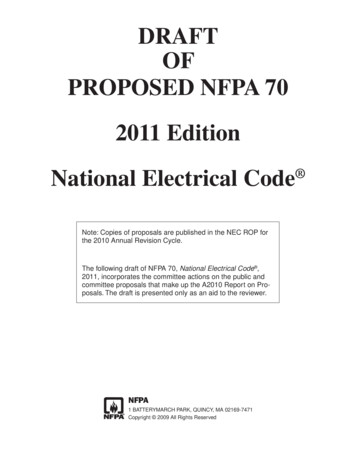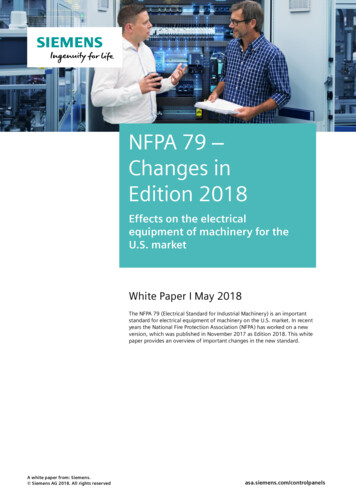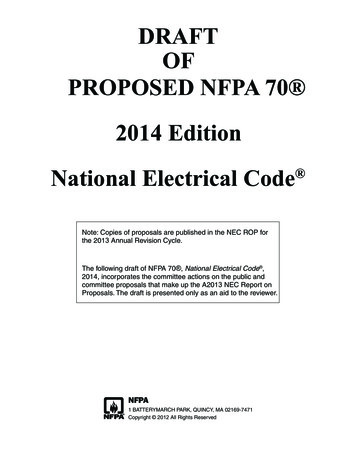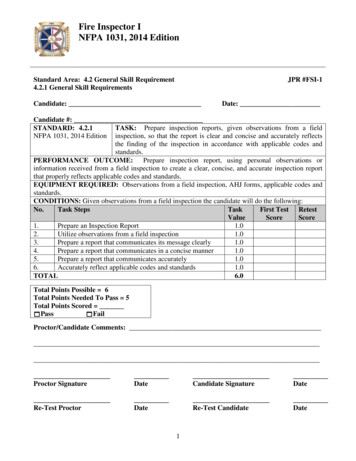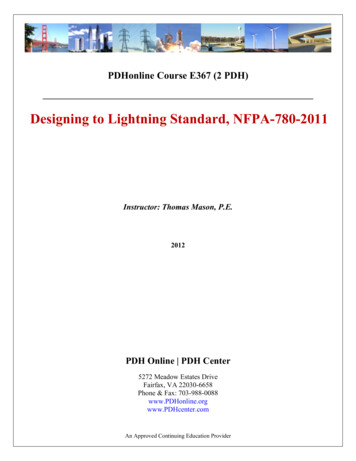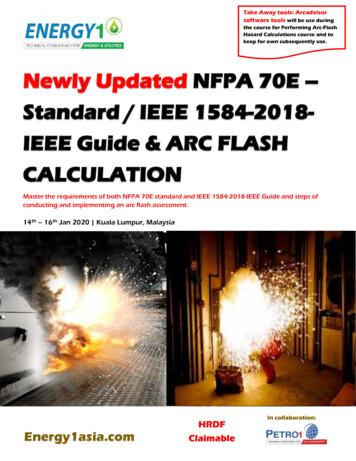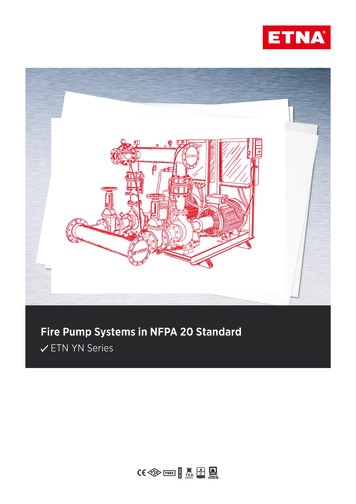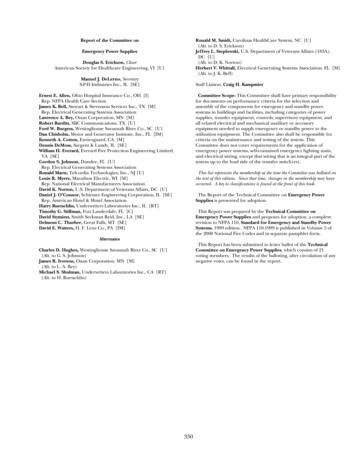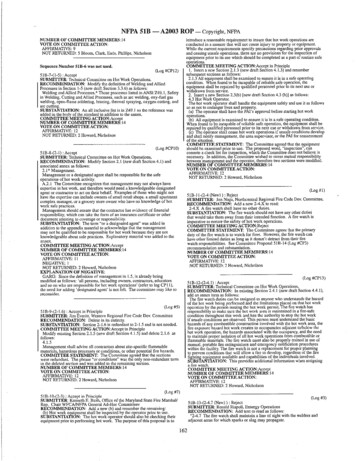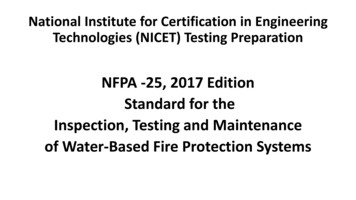
Transcription
National Institute for Certification in EngineeringTechnologies (NICET) Testing PreparationNFPA -25, 2017 EditionStandard for theInspection, Testing and Maintenanceof Water-Based Fire Protection Systems
Seminar Objectives Continued development of technicians who engage in the Inspection,Testing and Maintenance of water-based fire protection systems Understanding and familiarizing technicians with the applicablestandards and best practices using these standards Preparing the technician for NICET testing to achieve qualificationsand certifications
History of NICET Founded in 1961 (then ICET) A division of the National Society of Professional Engineers (NSPE) Currently has more than 148,000 technicians certified and growing! Extensive partner network and accreditation organizations (i.e. ANSI,NHI, ICC, etc.) Through continued professional development, certified techniciansdemonstrating skills and knowledge in subject matter will provideemployers and the public a higher degree of safety and protection
Applying for NICET Testing and CertificationsHave You: Registered with NICET, set up your account and received confirmationfor login and password information? Requested to test by filling out the water-based ITM testingapplication package for appropriate level and fees payed?. Oncesubmitted to NICET and accepted, you’ll receive an email confirmingtesting locations and dates. You need to schedule testing quickly to receive best Pearson VUEtesting locations near you. (Eligibility to test expires within 90 days!)NICET Website: www.nicet.org
NICET Testing PreparationWhat level are you testing for: Level I; Designed for technicians who perform limited job task underdirect supervision. Level II; Designed for technicians who perform routine inspectionsand inspection task under daily supervision Level III; Is for technicians who can work independently to performcomplete system inspection and testing jobs, and who may supervisethe work of other ITM technicians
NICET Testing Preparation (cont.)Which exam are you taking, multi-exam or single exam Multi exams were required prior to December 1st 2019, Two at level I,Three at level II & two at level III If started, you can continue with multiple exams through December2020 OR, you can switch to new single exam for that level. NOTE: If you switch to single exam per level, you will not receive anycredit for previous exams passed and you will not be able to switchback to multiple exams. If you complete all exam requirements at anylevel, you will be automatically switch to single exams at next level.
NICET Testing PrerequisitesHave You Completed: Level I testing; 6 months of involvement with water-based ITMactivities that may include combination of 3 months of “other” workexperience activities? Level II testing; Minimum 2 years work experience in water-basedITM activities including 3 months of “other” work experienceactivities? Level III testing; Minimum 5 years work experience in ITM activitiesincluding ITM reporting, impairment management and supervision ofa variety of systems and facilities?
NICET Certification ApplicationLevel’s I & II, Submit your testing application to include; Work History (Part #1). Detailed description of work performed includingtypes of task you performed, scope of projects worked and types ofmaterials, tools, machinery, systems and system components which youworked. Note any gaps or delays in work history. Experience-Verifier Data (Part #2); Ensure direct/indirect supervisor ormanager completes observations of your work/work outcomes. Experience-Performance Verifier (Part #3); Ensure direct/indirectsupervisor or manager completes appropriate level performance measures.Part IV Personal Recommendation not required for Levels I & II.Make sure your application is detailed and completely filled out withdates or will be delayed or rejected
NICET Certification Application (cont.)Other Work Experience Descriptions Acceptable for Levels I & II Water-based system installation, service or acceptance testing Government Enforcement for ITM water-based systems Insurance review of ITM Water-based fire protection system layout Fire alarm inspections
Are You Prepared to Test for NICET Certifications?Let’s get Started DO YOU have the applicable standard(s)?. Can be a copy bound andsecured in a 3-ringer binder with a title page. You can havehighlighted text as well. NOTE: NFPA Handbook is not allowed. DO YOU have your standard tabbed with self adhesive index tabs ordividers?. These must be permanently fixed or attached. No “stickynotes”, loose papers or modifications will be allowed into testingcenters. HAVE YOU opened your standard and familiarized yourself with ALLchapters including the annexes?. Your standard should havefingerprints and coffee stains on the pages!!.Knowing HOW to navigate your standard is key to testing!
Tabbing your Standard NFPA does provide index tabs with cost for all standards that is thepreferred method but you can use other tabs as well. Website is:catalog.nfpa.org or call 1-800-344-3555 You can use 1-1/2” peel and stick writable tabs than you can obtainfrom any office supply store. You’ll need to write chapters and contents on each tab. I would alsorecommend using a copier with label printing features. Will be neatand legible. When tabbing your standard, it is recommended to startin the back indexes at the bottom right corner and work your way upstaggering tabs through your standard.
Index Tab SamplesNFPA provided index tabsBasic tabs
Applicable Standards Referenced in NFPA-25
Referenced Material NFPA-25, 2017 Edition is the main standard for the inspection, testingand maintenance of water-based fire protection systems. This is thecurrent standard that NICET has adopted as of December 2019. Although informational, the technician should also have access toadditional standards that are considered “part of the requirements ofthis document”. You will need to reference and coordinate electricalcomponents and detection equipment used to activate pre-actionand deluge systems that are addressed in NFPA-72 or NFPA-20. By the way, what chapter in NFPA-72 would you find the ITM of firealarm devices?
NFPA -25, 2017 Edition Layout Consist of 16 Chapters including annexes A, B, C, D, E, F, G, H and IndexChapter 1 AdministrationChapter 9 Water Storage TanksChapter 2 Referenced PublicationsChapter 10 Water Spray Fixed SystemsChapter 3 DefinitionsChapter 11 Foam Water Sprinkler SystemsChapter 4 General RequirementsChapter 12 Water Mist SystemsChapter 5 Sprinkler SystemsChapter 13 Common Components/ValvesChapter 6 Standpipe & Hose Systems Chapter 14 Internal Piping/ObstructionChapter 7 Private Fire Service Mains Chapter 15 ImpairmentsChapter 8 Fire PumpsChapter 16 Special Requirements
NFPA-25 Annexes and IndexANNEXES: The annexes are not part of the standard but is included forinformational purposes only. The annex provides additionalexplanations numbered and corresponds with the text in the body ofthe standard. How do you know when there’s additional explanatoryinformation in the annex?.INDEX: The index will provide you key words or phrases showing pagenumbers which text on subject can be found. It’s typically placed atthe end of a book. (i.e. Drains, auxiliary 4.1.9.2 Main (see main drain)
The 1.1.2’sWhat does this mean?Starting at Chapter 5, ITM TABLES are designated 1.1.2 The tables are a summary of the inspections, testing andmaintenance. The tables provide the frequencies for ITM related to theitem, devices, equipment and the referenced chapters andsections. The tables will be your best friend when needing additionalinformation to locate within your standard and are typical inother standards as well.
Component Action RequirementsTables that provide component action requirements when they areadjusted, repaired, reconditioned and replaced. This table will also provide the technician with information forrequired actions and any testing criteria. Table will also advise on applicable chapters and conformanceincluding referenced standards. If the original installation standard is different from the citedstandard, the installing standard is permitted to be used.
Navigating your StandardAn intelligent person may not know all the answers,but has the ability to find them The key to successful testing is your ability to navigate your standard Permanently affixed tabs will assist you with finding information andis critical. NICET gives you approximately 1.8 minutes per question. Keywords (i.e. sprinkler, standpipe, fire pump, water tank, etc.) willdirect you to the applicable chapter.Proper Preparation Prevents Poor Performance!!
NICET Inspections & Testing Content OutlineLevel I:1.1 Safety; Wear and maintain PPE. Recognize lockout/tagout procedures Recognize hazards (confined spaces, holes, pits, etc.) Ladder safety Inspect and maintain tools, equipment and (GFCI) grounding Recognize impairment issuesNOTE: OSHA 29 CFR 1910 will provide you job knowledge required for ITMtechnician.
NICET Inspections & Testing Content OutlineLevel I:1.2 Identify Components, Condition and Operation ; Locate and read gauges. Locate and identify control valves and position, signage, drain/testvalves, mechanical alarms, supervisory devices, FDC’s, etc. Visually inspect components (e.g., pipe, hangers, bracing, sprinklers Identify system types (wet, dry, standpipe, etc.) Identify water supply (e.g., pumps, tanks, municipal supplies.) Verify trouble, supervisory and alarm signals
NICET Inspections & Testing Content OutlineLevel I:1.3 Prepare Preliminary Documents ; Identify correct reports for ITM task. Inventory system components Record size, make and models of sprinklers and valves Identify system types (wet, dry, standpipe, etc.) Prepare preliminary reports under the direct of Level II or Level IIItechnicians
NICET Inspections & Testing Content OutlineLevel I:1.4 Operate Components Under Direct Supervision ; Exercise control valves (e.g., OS&Y’s, PIV’s, WPIV’s and butterflyvalves). Test water flow alarms (e.g., water motor gong, pressure switches andvane type. Perform a main drain test and document results. Flushing of hydrants. Operate hose connections.
NICET Inspections & Testing Content OutlineLevel II:2.1 Safety; Implement proper use and maintaining PPE. Implement lockout/tagout. Address work hazards and implement procedures (confined space, holes,ceilings ladders, lifts, etc. Ensure ladder safety and proper use. Verify correct tools and equipment are used and maintained. Implement impairment procedures.NOTE: OSHA 29 CFR 1910 & 1926 will provide you job knowledge requiredfor ITM technician
NICET Inspections & Testing Content OutlineLevel II:2.2 Communication; Coordinate with customers (pre-post inspection interviews, scope ofwork review and notifications. Verify alarm companies, fire departments and AHJ’s are contacted. Deliver results and findings of ITM task to the customer of applicableparty.
NICET Inspections & Testing Content OutlineLevel II:2.3 Perform Document and Interpret Intermediate ITM Task; Perform ITM task for dry systems(e.g., QOD’s, air compressors,nitrogen generators and air maintenance devices. Perform ITM task for wet pipe (including anti-freeze systems). Perform ITM task for standpipe systems, fire pump systems, privatefire service mains and water storage tanks. Determine need for obstruction investigations and prevention. Identify and classify ITM deficiencies.
Let’s Practice with Timed Questions25 Questions 50 Minutes Questions will simulate a NICET test with allowing 2 minutes perquestion. (NICET level I allows approx. 1.5 minutes per question). If you finish prior to the allowed time, please be courteous to othersand allow them to complete test without distractions. Everyonelearns at a different pace and levels When answering questions, please provide section referencenumbers if you must look up the answer in your standard.Remember, this is an exercise to establish a baseline for you onwhere you may need to improve to prepare for successful testing.
Practice Questions1) NFPA 25 requires inspection records to be maintained by the .a) contractorb) fire departmentc) ownerd) all of the above2) Sprinklers are required to be inspected from the floor level .a)b)c)d)monthlyquarterlysemi-annuallyannually
Practice Questions3) The term Approved is defined by NFPA standards as “ ”.a) permissibleb) acceptable to the authority having jurisdictionc) allowabled) Not rejected.4) Testing is defined as a periodic check on a system.a) visualb) physicalc) operationald) hands-on
Practice Questions5) How many spare sprinklers are required in the spare sprinkler cabinet for a buildingwith 305 sprinklers installed?a) 6b) 24c) 18d) 126) The minimum allowable distance below a standard sprinkler and the top of storage is:a) 22”b) 12”c) 36”d) 18”e) 6”
Practice Questions7) NFPA 25 requires that inspectors of water based fire protection systems shallbe:a) be at least 18 years oldb) qualifiedc) certified by NICETd) licensed by the AHJ8) Antifreeze solutions used in CPVC piping systems are permitted to be:a) Glycerinb) Ethylene Glycolc) Propylene Glycold) a or c abovee) Diethylene Glycerol
Practice Questions9) The Authority Having Jurisdiction may be:a) Insurance companyb) Fire departmentc) Ownerd) All the above.10) What test shall be performed when a control valve is closed and reopened?.a) Valve status testb) Flow testc) Operational testd) Main drain test
Practice Questions11) Systems where the sole water supply is through a backflow preventer, maindrain tests are conducted on automatic wet standpipe systems:a) Quarterlyb) Annuallyc) Semi-annually.d) Monthly12) What is a private fire service main?
NFPA-25, 2017 Edition is the main standard for the inspection, testing and maintenance of water-based fire protection systems. This is the current standard that NICET has adopted as of December 2019. Although informational, the technician should also have access to additional standards that are considered “part of the requirements of this document”. You will need to reference and .
